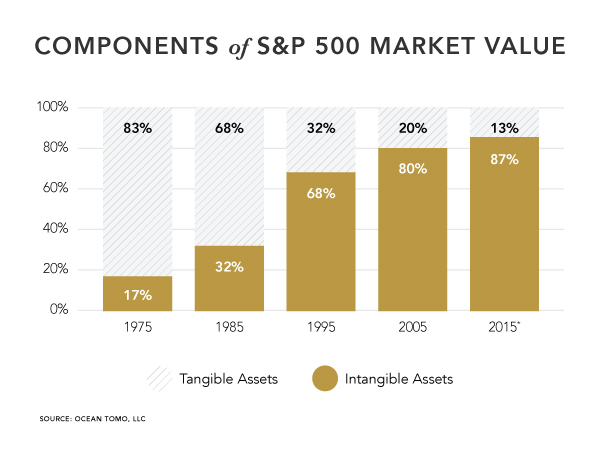You might not be aware of a trend in the corporate valuation world. You might not think that developments in how companies are being valued by the financial world would be of interest to HR. But, hold on to your horses! Validation of “our people are our greatest asset” is here!
Ocean Tomo LLC, the Intellectual Capital Merchant Banc™ firm, publishes a periodic study of intangible asset market value. The most recent, published in early 2015, includes a rather eye-popping chart. But first a couple of definitions:
- Tangible Asset (from Investopedia): A tangible asset is an asset that has a physical form. Tangible assets include both fixed assets, such as machinery, buildings and land, and current assets, such as inventory. The opposite of a tangible asset is an intangible asset.
- Intangible Asset (also from Investopedia): An intangible asset is an asset that is not physical in nature. Corporate intellectual property (items such as patents, trademarks, copyrights, business methodologies), goodwill and brand recognition are all common intangible assets in today’s marketplace.
Tangible assets are things. Physical things. Intangible assets are the results of human intellect and work. And the financial value of those – tangible and intangible assets – have completely reversed in the last 40 years. Completely!
Ocean Tomo provides the following chart showing this complete reversal.
 If ever the argument was made that our people are, in fact, our biggest asset, this nails it. In 1975 tangible assets comprised 83% of the S&P 500 market value; in 2015 intangible assets made up 84% of the S&P 500 market value. That means people, human beings are the greatest driver of corporate value — and not by a little bit.
If ever the argument was made that our people are, in fact, our biggest asset, this nails it. In 1975 tangible assets comprised 83% of the S&P 500 market value; in 2015 intangible assets made up 84% of the S&P 500 market value. That means people, human beings are the greatest driver of corporate value — and not by a little bit.
So here’s the question: If the finance/valuation world is truly valuing our organizations based on the value of our human capital, why is it so hard to talk about – much less act upon – the value of building cultures fit for human beings?
This originally appeared on China Gorman’s blog at ChinaGorman.com.
